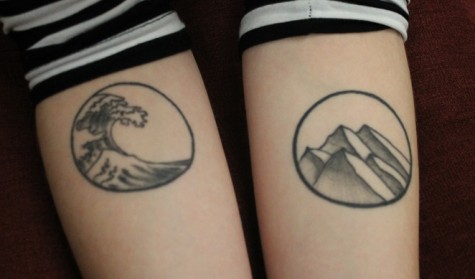Homeless Pete and the extravagant tattoo tent
When tattoos are owtlawed for underage students some find alternatives
A new tatoo being applied in Homeless Pete’s tent
“In the thicket beyond the creek, far past the ruckus of the city, beneath the towering pines and birch; that is where you will find him.” The boy set out alone on his quest, his only companions the luminous moon and the wilderness at his fingertips. Trekking through the ominous forest, he finds himself pondering the decision to make the journey. While in thought, he found his strenuous endeavor was at its end. He had finally found him: Homeless Pete and his extravagant Tattoo Tent.
To many minors today, finding someone willing to give them a tattoo may seem like a children’s fairytale adventure – minus the cliche fairytale ending. Though our character may be fictional, Homeless Pete and the events described are fact. Since 2013, nobody under the age of 18 in the state of Minnesota can legally obtain a tattoo – and artists cannot legally tattoo a minor – making it very difficult to get one. Regardless, when walking through a modern high school hallway, it is clear that this law has been all but obeyed; though illegal, children are receiving tattoos. This form of self expression can prove fatal, and their methods of getting a tattoo can lead to much more than regret. Even with this possibility, though, many minors receive healthy tattoos they adore.
As he sits aside the canvas abode in the brush, Homeless Pete recounts for the boy his life before the tent, filled with sex, drugs, and rock n’ roll; The 1970’s punk revolution. Pete had done it all (and then some) with his rock band. They would demolish cars on the sides of roads, egg houses, smash mailboxes. In short, they were vandals; and they loved it; and only to aid their social image, all of them were heavily tattooed.
This trashy image of tattooed teens has evolved throughout the past 40 years, though, as tattoos have become more widely accepted. A 2012 Harris poll claimed that nearly 1 out of 5 people in the world have at least one tattoo. The stigma of inked adolescents has become, in itself, neutral. No longer are they seen as hooligans and troublemakers, but nearly at the same level as those without tattoos. “If you watch any type of sporting event anymore, players are completely covered in tattoos;” Cannon Falls High School principal Tim Hodges suggests, “It’s become mainstream. When it becomes that way, when people see entertainers doing those kinds of things, it’s more accepted. Kids are being influenced.” It is evident when watching almost any form of entertainment that tattoos have become extremely prevalent in modern culture. With teenagers being as impressionable as they are, seeing their inked idols may trigger them to make the same choices, only earlier in life.

author’s tattoos
Homeless Pete beckons the boy into the tent, and though hesitant, he follows. Upon entry, the once shoddy fort had transformed at once into a marvelous display of art and gadgets. A tattoo machine made from an old hair dryer lay in the corner on a broken three-legged end table, and Pete’s art was strewn throughout the tiny abode, upon walls, chairs, tables. Though the floor may be packed in dirt and rats may scurry between furnishings and over feet, the boy’s stomach twists into a knot with giddy, Christmas Morning excitement. This is the place.
When the ban went into effect, no longer could a minor simply waltz into a tattoo parlor with a forged note from Mom or Dad saying their beloved son or daughter could get a tattoo. It had become completely illegal for a child under the age of 18 to be at either end of the needle. This displaced all minors in line for legal, healthy tattoos and left them searching for their alternative, their ‘place’; the basement, party, or tent at which they would finally obtain the tattoo they so desired. The reality is that laws don’t stop human beings from chasing their desires. Just as a drug addict will find a way to get their fix, kids will find their ways to get tattoos, and both come with their risks. Hepatitis and C, Tetanus, HIV, and other bloodborne pathogens are ever present risks when getting a tattoo. If the artist reuses needles, or fails to clean these needles properly, any disease the previous client had swimming through their bloodstream is now on the needle and under the skin of it’s next victim. This is especially dangerous when considering teenage tattoos, as the majority of the procedures are done by other teenagers within home studios in a style referred to as Stick n’ Poke. These tattoos require little more than a sewing needle, pen ink, and all the courage the client can muster. More often than not, these kids do not know what they’re doing and will inevitably aid the spread of sometimes fatal ailments in the name of self expression.
The boy sits in the red velour armchair next to the tattoo gun, his arm under a bright light. Pete sits to his right, tinkering with a bent needle. Re-examining the situation, the child takes a moment to consider the outcomes. He could have the tattoo of his dreams, permanent disgrace. His life would become one of long sleeved shirts and shame. His parents could kick him out. Willing to take whatever risk, He bites his tongue and braces for what seems to be the opportunity of a lifetime. The buzz of the makeshift machine resounds throughout the tiny tent, and his decision is set in stone – or skin.
“It was an alright idea. It was iffy,” laughed a tattooed student, “I would do it again. But I’d get it professionally done.” With many minors (and adults), there comes regret following a subpar tattoo. According to the Daily Mail, one in six people want their tattoo(s) removed. This isn’t always the case, though, as this statistic also shows that five out of six people do not hate their ink. With such a great majority still in love with their permanent form of self expression, the argument that adolescents getting tattooed will surely lead to regret is proven redundant and worn thin. There is no evidence that every teenager who gets tattooed will end up with regret and a wardrobe filled with long sleeved shirts and sweatshirts.
Upon the boy’s safe (if not a little sore) return to his home, he’d found his parents fast asleep. Figuring it was only a few hours until they’d be awake, he stayed in the living room, readying himself for whatever punishment would come when they saw the design scrawled across his forearm. In the movies, parents are livid when kids come home with tattoos, so he was prepared to be thrown out, to live a life not unlike that of Pete. He was ready for his parents to profess his eternal damnation, to disown him. To the boy’s surprise, none of this happened. There was the expected (and lengthy) “not angry, just disappointed” conversation, but he still lives in his house. Though thoroughly interrogated by friends and teachers, there wasn’t ridicule. He wasn’t considered a rebel, or a burnout, or whatever titles may have come with his choice twenty years ago. All he is is all he was before the adventure to find Homeless Pete and his extravagant Tattoo Tent.

Meta-Pseudo extraterrestrial teenager. I wear thick rimmed glasses and listen to music you've probably never heard of. Stay livid.

